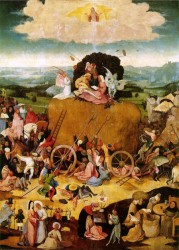
Vandenbroeck 1987b
“Jheronimus Bosch’ Hooiwagen: enkele bijkomende gegevens” (Paul Vandenbroeck) 1987
[in: Jaarboek Koninklijk Museum voor Schone Kunsten Antwerpen, 1987, pp. 107-142]
After having pointed out that a ‘chariot of Evil’ and the appearance of Christ in the clouds are not original Boschian ideas, Vandenbroeck suggests that by painting Orientals in the central panel of the Haywain triptych Bosch wanted to allude to the universality of Evil. He is surprised, though, that Bosch did not represent any Jews. Next the author offers a survey of a whole series of medieval texts and images ‘that have escaped the attention of researchers so far’ in which hay plays a part. He also pays attention to the turnips (rapen) motif which is similar to the hay motif.
From all this Vandenbroeck concludes that – contrary to what Grauls thought – the Old Testament view on hay was known in the Netherlands around 1500 [p. 123] and that the hunt for hay not only refers to greed but to human folly and the earthly vanities in general. The message of Bosch’s Haywain could then be paraphrased as follows: ‘People from all social layers and countries are obsessed by the desire for worthless earthly pleasures (especially sub specie luxuriae) and possessions, but because of this they are the victims of diabolical fraud and temptation, they forget God and themselves and are heading for eternal damnation’ [p. 139].
At the end of his article Vandenbroeck talks about ‘profane symbolism’ when it comes down to Bosch’s Haywain. His hay symbolism is said to suggest that an ‘elitarian’ culture borrowed and adapted folkoristic motifs and ideas, or that an ‘intermediary’ cultural layer fused elements from the ‘higher’ and the ‘lower’ culture.
These latter statements not only seem confusing (the author promises to write more about them elsewhere) but also disputable: with Bosch and for instance also in the 1563 Antwerp Ommegang (Parade) the hay motif clearly functions in a religious context and the origin of the hay symbolism in the late Middle Ages is not folkloristic but biblical. Elsewhere in late-medieval culture hay did appear in a profane context, for example in amorous-erotical texts written by Rederijkers (Rhetoricians).
[explicit]